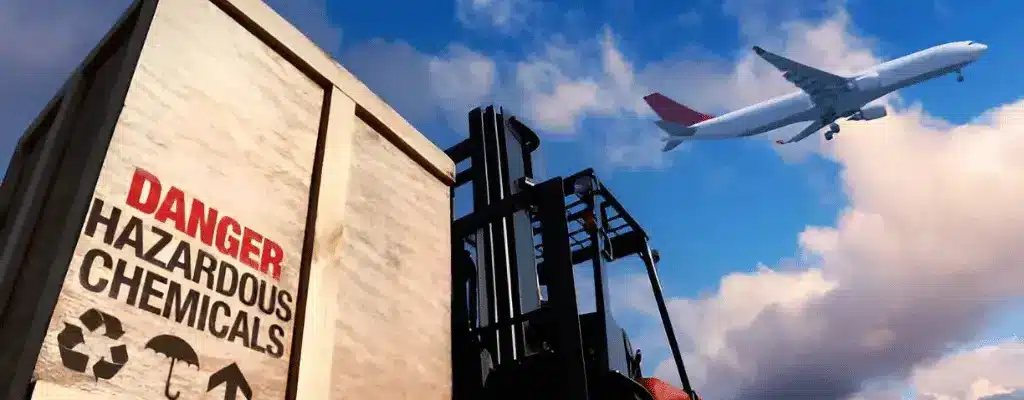In today’s complex and dynamic world of international trade, some shipments require special attention and care. Dangerous goods, materials with potentially harmful characteristics for humans, the environment, and property, fall into this category of sensitive shipments. The safe and secure transport of these goods is not only an ethical responsibility but also an unavoidable legal and commercial necessity. The slightest error in the process of transporting dangerous goods can have irreparable consequences, from heavy financial losses to catastrophic personal injuries and environmental damage.
Therefore, choosing a specialized and reliable transport company plays a key role in ensuring the safety and security of the dangerous goods supply chain. Mobin Asa Tarabar, as a leading international transport company, relying on years of experience, expertise, and up-to-date technical knowledge, offers dangerous goods shipping services with unparalleled safety, reliability, and expertise to its customers.
At Mobin Asa Tarabar, by strictly adhering to international conventions and the strict guidelines of IMDG, IATA, and ADR, we are prepared to transport various types of dangerous goods, including chemicals and toxic substances, explosives and flammable materials, radioactive shipments, corrosive and reactive materials, and environmentally sensitive goods in all modes of transport (sea, land, and air).
Our guarantee to you is more than just a claim:
- Specialized and standard packaging according to the latest international requirements.
- Accurate and clear labeling of shipments for safe identification and handling.
- Trained and specialized personnel in the field of transport and risk management of dangerous goods.
- Full and unquestionable compliance with safety and environmental requirements at all stages of transport.
What are Dangerous Goods and Their Types?
To better understand the requirements for transporting dangerous goods, we must first know what dangerous goods mean and what types they are. Generally, dangerous goods refer to any substance or object that, due to its physical or chemical properties, can be hazardous to human health, public safety, the environment, or property. This hazard can manifest under normal transport conditions, or in the event of accidents such as fire, leakage, or explosion.
Definition of Dangerous Goods and Their Classification Based on IMDG, IATA, and ADR
In order to create an international framework for the safe transport of dangerous goods, various international organizations have developed classification systems and regulations. The most important of these regulations in the transport industry are:
- IMDG Code (International Maritime Dangerous Goods Code): The International Maritime Dangerous Goods Code. This code has been developed by the International Maritime Organization (IMO) and provides comprehensive regulations for the maritime transport of dangerous goods.
- IATA Dangerous Goods Regulations (DGR): The Dangerous Goods Regulations of the International Air Transport Association (IATA). These regulations set global standards for the air transport of dangerous goods and focus heavily on safety in this mode of transport.
- ADR (European Agreement concerning the International Carriage of Dangerous Goods by Road): The European Agreement concerning the International Carriage of Dangerous Goods by Road. This agreement regulates the road transport of dangerous goods in Europe and member countries and is widely used internationally as a reference.
These regulations classify dangerous goods based on their main type of hazard into 9 main classes:
Table of Dangerous Goods Classification Based on IMDG, IATA, and ADR:
| Class | Class Name | Examples of Common Goods |
|---|---|---|
| 1 | Explosives | Explosives, ammunition, fireworks |
| 2 | Gases | Flammable gases (e.g., propane), non-flammable and non-toxic gases (e.g., nitrogen), toxic gases (e.g., chlorine) |
| 3 | Flammable Liquids | Gasoline, paints, alcohols |
| 4 | Flammable Solids; Substances Liable to Spontaneous Combustion; Substances which, in contact with water, emit flammable gases | Sulfur, matches, calcium carbide |
| 5 | Oxidizing Substances and Organic Peroxides | Ammonium nitrate, hydrogen peroxide |
| 6 | Toxic and Infectious Substances | Pesticides, cyanides, laboratory samples |
| 7 | Radioactive Material | Radiopharmaceuticals, uranium |
| 8 | Corrosive Substances | Sulfuric acid, sodium hydroxide |
| 9 | Miscellaneous Dangerous Substances and Articles | Lithium batteries, magnetized materials, environmentally hazardous substances |
Each class may also be divided into subdivisions that provide a more precise classification based on the degree of hazard and specific characteristics of the substances. For example, Class 3 (Flammable Liquids) is itself divided into three packing groups, which differ based on flash point and degree of hazard.
Common Examples of Dangerous Goods in Transport
Dangerous goods are not limited to explosives and toxic substances. Many everyday and industrial products that we deal with are classified as dangerous goods. Some common examples include:
- Chemicals: Various acids, bases, solvents, paints, adhesives, resins, fertilizers, petrochemical and pharmaceutical raw materials.
- Petroleum Products: Gasoline, diesel, crude oil, lubricating oils, petroleum solvents.
- Gases: Various industrial, medical, and household gases such as propane, butane, acetylene, oxygen, nitrogen, chlorine, and ammonia.
- Explosives and Fireworks: Industrial explosives, military explosives, commercial and recreational fireworks.
- Radioactive Materials: Radiopharmaceuticals, radioactive materials used in industry and research, radioactive waste.
- Lithium Batteries: Lithium-ion batteries used in mobile phones, laptops, electric vehicles, and other electronic devices.
- Infectious Substances and Laboratory Samples: Blood and tissue samples, pathogenic microorganisms, hospital waste.
- Consumer Products Containing Dangerous Goods: Perfumes, air freshener sprays, nail polish, detergents and cleaning agents, household pesticides.
Note: This list only includes examples of dangerous goods, and many other materials and products may also be included in this classification. To ensure the correct classification of your goods and their transport requirements, always refer to the IMDG, IATA, and ADR regulations and consult with dangerous goods transport experts such as Mobin Asa Tarabar.
The Importance of Compliance with Laws and Regulations in the Transport of Dangerous Goods
The transport of dangerous goods is a high-risk activity that, without strict and unquestionable compliance with international and national laws and regulations, can turn into a complete disaster. The importance of these laws and regulations is not only limited to protecting human lives and the environment, but the health of global trade and the sustainability of the supply chain also depend on their correct implementation. In this section, we will examine the various aspects of the importance of complying with laws and regulations in the transport of dangerous goods.
Responsibilities of the Shipper, Carrier, and Consignee
In the dangerous goods transport chain, the responsibility for safety rests with all stakeholders. Laws and regulations have established specific duties and obligations for each of the involved parties:
- Shipper: The shipper of the goods is the first and main responsible party in the safe transport chain of dangerous goods. The key duties of the shipper include:
- Correct Classification of Goods: Accurately determining the class and subdivision of the hazardous goods being shipped based on their physical and chemical characteristics.
- Appropriate and Standard Packaging: Selecting and using approved and durable packaging that is resistant to transport conditions and potential hazards.
- Accurate Marking and Labeling: Affixing correct and legible warning labels and markings on packages and containers in accordance with regulations.
- Preparation and Provision of Transport Documents: Accurately and correctly completing dangerous goods transport documents, including the goods declaration, Material Safety Data Sheet (MSDS), and other required documents.
- Full and Transparent Information to the Carrier: Providing complete and accurate information about the nature, hazards, and transport conditions of the dangerous goods to the transport company.
- Carrier: The transport company is responsible for the safe transport of goods from the origin to the destination. The key duties of the carrier include:
- Acceptance of Shipments in Compliance with Regulations: Ensuring that the shipment complies with legal requirements in terms of packaging, labeling, and documentation.
- Use of Appropriate Transport Vehicles: Using approved vehicles and equipment suitable for transporting the specific type of dangerous goods.
- Personnel Training and Qualification: Ensuring sufficient training and qualification of personnel involved in the transport of dangerous goods, including drivers, loading and unloading workers, and administrative staff.
- Compliance with Permitted Routes and Traffic Restrictions: Choosing safe and permitted routes for the transport of dangerous goods and complying with relevant speed and traffic restrictions.
- Preparation for Emergency Situations: Preparing emergency response plans and necessary equipment to deal with potential incidents during transport.
- Maintaining Cargo Security: Preventing theft, damage, and unauthorized access to the shipment during transport.
- Consignee: The consignee also plays a role in the safety chain and has the following responsibilities:
- Acceptance of Shipment in Compliance with Regulations: Inspecting the documents and packaging of the shipment upon delivery and ensuring its compliance with the order and legal requirements.
- Safe Unloading and Handling: Performing unloading and handling operations at the destination with adherence to safety principles and using appropriate equipment.
- Proper Storage and Warehousing: Storing dangerous goods in authorized warehouses and in accordance with the storage conditions specified in regulations and the Material Safety Data Sheet (MSDS).
- Waste and Residue Management: Proper and safe disposal of waste and residues resulting from dangerous goods in accordance with environmental regulations.
International and National Standards for the Transport of Dangerous Goods
Compliance with the laws and regulations for the transport of dangerous goods is not limited to the domestic laws of countries. International standards play a vital role in creating harmonization and ensuring safety in the cross-border transport of these materials. The most important international standards are:
- IMDG Code: As mentioned earlier, the IMDG Code is the main reference for regulations on the maritime transport of dangerous goods worldwide and is widely implemented by member countries of the International Maritime Organization (IMO).
- IATA DGR: The IATA DGR regulations are the global standard for the air transport of dangerous goods and are used by all member airlines of the International Air Transport Association (IATA) and many civil aviation organizations around the world.
- ADR: The ADR agreement, although initially developed for road transport in Europe, is recognized as an international reference in the road transport of dangerous goods due to its comprehensiveness and high technical details, and many countries use its provisions in their national laws.
In addition to these international standards, each country has also developed its own national laws and regulations in the field of transporting dangerous goods, which are usually adapted based on international standards and taking into account specific domestic conditions. Transport companies are obliged to be fully aware of and comply with both international laws and the national laws of the countries of origin, destination, and transit.
Dangerous Goods Shipping Services at Mobin Asa Tarabar
Mobin Asa Tarabar, with a deep understanding of the complexities and sensitivities of dangerous goods transport, offers a comprehensive and specialized set of services to meet the diverse needs of customers in this field. Relying on up-to-date technical knowledge, extensive operational experience, and an unwavering commitment to safety, we provide the best solutions for the safe, secure, and legal transport of your dangerous goods.
Mobin Asa’s Expertise and Experience in Transporting Various Types of Dangerous Goods
Mobin Asa Tarabar’s brilliant track record and long-term experience in the international transport industry are a solid foundation for providing specialized dangerous goods transport services. Our specialized and trained team, with complete mastery of national and international laws and regulations, is knowledgeable in all aspects of the safe transport of these materials. Our expertise includes:
- Transporting Various Classes of Dangerous Goods: We are prepared to transport all 9 main classes of dangerous goods classified according to IMDG, IATA, and ADR. Our diverse services include explosives (Class 1), gases (Class 2), flammable liquids (Class 3), flammable solids (Class 4), oxidizing substances (Class 5), toxic and infectious substances (Class 6), radioactive materials (Class 7), corrosive substances (Class 8), and miscellaneous dangerous substances and articles (Class 9).
- Various Modes of Transport: We offer dangerous goods transport services in all three main modes of international transport (sea, land, and air). This diversity allows us to choose the best and most efficient transport solution based on the type of goods, route, budget, and your schedule.
- Extensive International Transport Routes: Our wide network of international partners and representatives in key locations around the world provides extensive coverage of dangerous goods transport routes. We are able to transport your shipments from origin to various destinations around the world in full compliance with legal and safety requirements.
Mobin Asa’s Permits and Certifications
Mobin Asa Tarabar is aware of the importance of complying with laws and regulations and obtaining the necessary permits for transporting dangerous goods. By obtaining valid permits from relevant domestic and international organizations and adhering to legal requirements, we bring peace of mind to our customers. Some of our key permits and certifications include:
- Dangerous Goods Transport Permit from National Transport Organizations: This permit indicates Mobin Asa Tarabar’s competence and official approval to operate in the field of domestic and international transport of dangerous goods.
- Personnel Training Certificates in IMDG, IATA, and ADR: Our specialized personnel have successfully completed specialized training courses in the regulations for the maritime (IMDG Code), air (IATA DGR), and road (ADR) transport of dangerous goods and hold valid international certificates. This ensures our team’s knowledge and skills in managing dangerous shipments safely.
- Quality and Safety Management System Certificates: Mobin Asa Tarabar, by establishing quality and safety management systems based on international standards, continuously improves its processes and ensures compliance with the highest levels of safety and quality in providing services.
Special Equipment and Facilities for the Safe Transport of Dangerous Goods
The safe transport of dangerous goods requires special equipment and facilities. Mobin Asa Tarabar, by investing in this field, has provided the most advanced facilities for the secure transport of dangerous shipments:
- Specialized and Approved Vehicles: Our transport fleet includes trucks, trailers, and cargo aircraft equipped with special safety equipment and approved for transporting various types of dangerous goods. These equipment include fire extinguishing systems, ventilation systems, insulation, etc., which are selected and used based on the type of dangerous goods and legal requirements.
- Special Containers for Transporting Dangerous Goods: We use standard and specialized containers approved for the sea and land transport of dangerous goods. These containers have special features such as impact resistance, leak-proofness, and ventilation systems that ensure the safety of the cargo during the journey.
- Standard Packaging and Labeling Equipment: We use high-quality packaging materials in accordance with international standards and valid and durable warning labels and markings for accurate labeling of shipments.
- Authorized and Safe Warehouses for Temporary Storage: If temporary warehousing of dangerous goods is required during the multimodal transport process, we use authorized warehouses that meet all safety and security requirements for storing these materials.
The Dangerous Goods Transport Process at Mobin Asa
Mobin Asa Tarabar carries out the dangerous goods transport process with great care and precision and in full compliance with all legal and safety procedures:
- Consultation and Initial Assessment: At the beginning of the process, our expert consultants carefully examine the type of goods, volume, route, and special transport conditions, and suggest the best transport solution to you, fully explaining the relevant legal and safety requirements.
- Accurate Classification and Documentation: In cooperation with the shipper, we ensure the correct classification of the goods according to IMDG, IATA, and ADR regulations and prepare and complete all required documents and documentation, including the goods declaration, Material Safety Data Sheet (MSDS), and relevant permits.
- Standard Packaging and Labeling: Our experienced team carries out the packaging of goods in accordance with international standards and using appropriate materials, and affixes accurate labeling and markings on packages and containers.
- Selection of Appropriate Transport Vehicle and Safe Route: We select the most suitable approved transport vehicle and a safe and permitted route based on the type of goods and the transport route, and we obtain all necessary permits for transport on specific routes.
- Safe Loading, Transport, and Unloading: Our trained personnel perform loading, transport, and unloading operations in full compliance with safety principles and using appropriate equipment. During the transport route, we continuously monitor and track the status of the shipment.
- Provision of Complete Documents and Reports: After successful completion of the transport and delivery of the goods to the consignee, we provide you with all transport documents and related reports.
Mobin Asa Tarabar, by providing specialized and comprehensive dangerous goods transport services, assures you that your sensitive shipments will reach their final destination with the highest level of safety and security.







